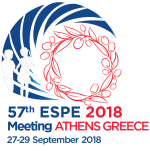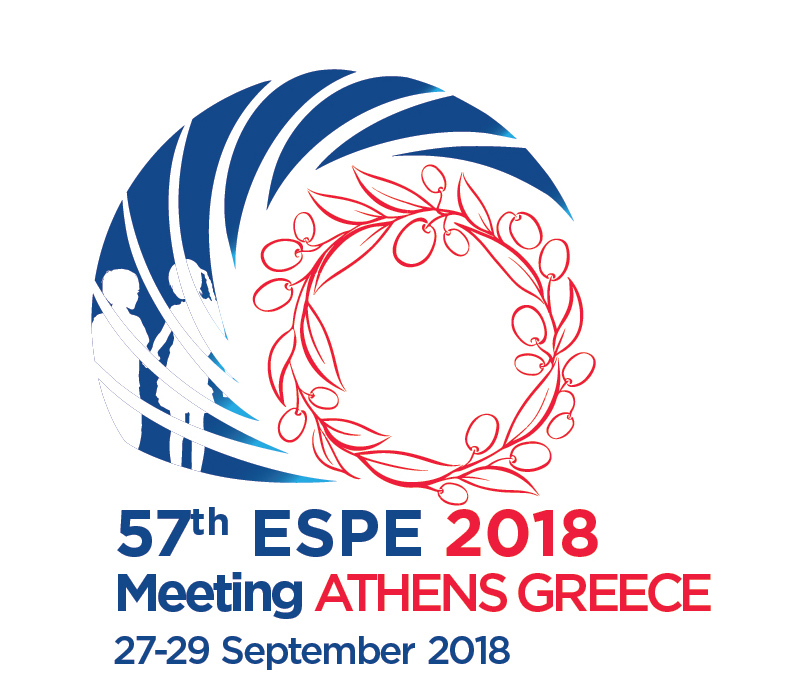
57th Annual ESPE
Athens,
Greece
27 Sep 2018 - 29 Sep 2018

Poster Presentations
Bone, Growth Plate & Mineral Metabolism P2
hrp0089p2-p036 | Bone, Growth Plate & Mineral Metabolism P2 | ESPE2018
Length Estimation Based on Clinical and Anthropometric Measures in Newborns
Beauregard-Paz Martha , Miranda-Lora America L. , Cruz-Hernandez Ana M. , Rivas-Rivas Rodolfo , Klunder-Klunder Miguel
hrp0089p2-p037 | Bone, Growth Plate & Mineral Metabolism P2 | ESPE2018
Vitamin D Deficient (Nutritional) Rickets Presenting in Infancy
Prematilake Dilusha , Hashim Raihana , Kollurage Udeni , Atapattu Navoda
hrp0089p2-p038 | Bone, Growth Plate & Mineral Metabolism P2 | ESPE2018
The Effect of Vitamin D Receptor Polymorphism on Bone Mineral Density in Egyptian Patients with Beta Thalassemia Major
Aly Abbassy Hadeer , Abdel Haleem Abo Elwafa Reham , Magdy Omar Omneya , Emadeldin Nassar Aliaa
hrp0089p2-p039 | Bone, Growth Plate & Mineral Metabolism P2 | ESPE2018
Vitamin D in Adolescents: A Comprehensive Review of Guidelines and Recommendations
Patseadou Magdalini , Haller Dagmar
hrp0089p2-p040 | Bone, Growth Plate & Mineral Metabolism P2 | ESPE2018
X-linked Hypophosphatemia Registry – An International Prospective Patient Registry
Padidela Raja , Nilsson Ola , Linglart Agnes , Makitie Outi , Beck-Nielsen Signe , Ariceta Gema , Schnabel Dirk , Brandi Maria Luisa , Boot Annemieke , Jandhyala Ravi , Moeller Gerd , Levtchenko Elena , Mughal Zulf
hrp0089p2-p041 | Bone, Growth Plate & Mineral Metabolism P2 | ESPE2018
Clinical and Biological Parameters Associated to the Severity of X-linked Hypophosphatemia in Children
Salcion-Picaud A , Rothenbuhler A , Etcheto A , Molto A , Briot K , Linglart A
hrp0089p2-p042 | Bone, Growth Plate & Mineral Metabolism P2 | ESPE2018
High Fibroblast Growth Factor (FGF) 23: An Unusual Cause of Severe Osteoporosis in a Patient with Chronic Liver Disease
Ng Nicholas Beng Hui , Lee Yung Seng , Sng Andrew Anjian , Aw Marion Margaret , Loke Kah Yin
hrp0089p2-p043 | Bone, Growth Plate & Mineral Metabolism P2 | ESPE2018
Metabolic Syndrome in Children with X-linked Hypophosphatemic Rickets (XLHR)
Lambert Anne-Sophie , Saadeddine Sanaa , Rothenbuhler Anya , Ussardi Alessia , Trabado Severine , Linglart Agnes
hrp0089p2-p044 | Bone, Growth Plate & Mineral Metabolism P2 | ESPE2018
High Incidence of Cranial Synostosis and Chiari Malformation in Children with X-linked Hypophosphatemic Rickets
Rothenbuhler Anya , Bacchetta Justine , Fadel Nathalie , Lambert Anne Sophie , Adamsbaum Catherine , Linglart Agnes , Rocco Federicco Di
hrp0089p2-p045 | Bone, Growth Plate & Mineral Metabolism P2 | ESPE2018
An Unusual Case of Hypophosphatemia in a Child Affected by Di George Syndrome
Kalapurackal Mila Ann , Barzaghi Federica , Pitea Marco , Cassano Gilda , Weber Giovanna
hrp0089p2-p046 | Bone, Growth Plate & Mineral Metabolism P2 | ESPE2018
Novel SLC34A1 Mutation in a Girl Infant with Idiopathic Infantile Hypercalcemia
hrp0089p2-p047 | Bone, Growth Plate & Mineral Metabolism P2 | ESPE2018
A Novel Variant of SLC34A1 Gene in an Infant with Idiopathic Infantile Hypercalcemia
Lee Gi-Min , Moon Jung-Eun , Kim Hyeon-A , Lee Su-Jeong , Ko Cheol-Woo
hrp0089p2-p048 | Bone, Growth Plate & Mineral Metabolism P2 | ESPE2018
Infantile Arterial Calcification and Subsequent Hypophosphatemia due to ENPP1 Mutation – A Case Followed through to Adulthood
Nour Munier , Inman Mark , Arnason Terra
hrp0089p2-p049 | Bone, Growth Plate & Mineral Metabolism P2 | ESPE2018
Pediatric Quality of Life Inventory in Children with Osteogenesis Imperfect in Dr Soetomo Hospital Surabaya
hrp0089p2-p050 | Bone, Growth Plate & Mineral Metabolism P2 | ESPE2018
Osteoporosis-pseudoglioma Syndrome (OPPG): Improvement of Osteoporosis on Biphosphonate Therapy
Karakilic Ozturan Esin , Altunoglu Umut , Derya Kardelen Asli , Yavas Abali Zehra , Avci Sahin , Kayserili Karabey Hulya , Poyrazoglu Sukran , Bas Firdevs , Darendeliler Feyza
hrp0089p2-p051 | Bone, Growth Plate & Mineral Metabolism P2 | ESPE2018
Bone Marrow Adiposity and IGF System in Obese Children and Adolescents
Darrigo Emiliana , Sader Soraya , Siena Thais , Nogueira-Barbosa Marcelo , Elias Jr. Jorge , Custodio Rodrigo , Ferraz Ivan , Liberatore Jr. Raphael , Del Ciampo Luiz , Jose Albuquerque de Paula Francisco , Martinelli Jr Carlos
hrp0089p2-p052 | Bone, Growth Plate & Mineral Metabolism P2 | ESPE2018
Evaluation of Bone Mineral Density in a Cohort of Children with Growth Hormone Deficiency
Cenciarelli Valentina , Bruzzi Patrizia , Predieri Barbara , Cerbone Caterina , Madeo Simona , Leo Francesco
hrp0089p2-p053 | Bone, Growth Plate & Mineral Metabolism P2 | ESPE2018
Follow-up on Bone Health in Children with Acute Lymphoblastic Leukemia (ALL)
Brenzoni Luciana , Cassinelli Hamilton , Bergada Ignacio
hrp0089p2-p054 | Bone, Growth Plate & Mineral Metabolism P2 | ESPE2018
Effect of Pubertal Inductionn Bone Mass Accrual, in Adolescent Boys with Duchenne Muscular Dystrophy
Zacharin Margaret , Lee Samantha , Taylor Miller Tashunka , Simm Peter , Munns Craig
hrp0089p2-p055 | Bone, Growth Plate & Mineral Metabolism P2 | ESPE2018
Oxandrolone Improves the Linear Growth and Osteoporosis in Teenage Bays with Osteogenesis Imperfecta
Salehpour Shadab , Setavand Somayeh , Shiari Reza , Reza Yassaee Vahid , Vafadar Mehdi , Tavakoli Saeed
hrp0089p2-p056 | Bone, Growth Plate & Mineral Metabolism P2 | ESPE2018
First Reported Cases of a Novel Variant of GNAS 1 Gene
Fafoula Olga , Panagiotakou Argyro , Grivas Grigorios , Fryssira Eleni , Kosteria Ioanna , Korovessi Paraskevi , Kostaridou Stavroula
hrp0089p2-p057 | Bone, Growth Plate & Mineral Metabolism P2 | ESPE2018
An Unusual Cause of Short Stature
Betul Kaygusuz Sare , Atay Zeynep , Kirkgoz Tarik , Guran Tulay , Bereket Abdullah , Turan Serap
hrp0089p2-p058 | Bone, Growth Plate & Mineral Metabolism P2 | ESPE2018
Validation of an Automated Method (BoneXpert) for the Determination of Bone Age in Paediatric Endocrinology – A Single Centre Experience
Calder Alistair , Dastamani Antonia , Spoudeas Helen , Dattani Mehul
hrp0089p2-p059 | Bone, Growth Plate & Mineral Metabolism P2 | ESPE2018
Arthrogryposis Multiplex Congenita Type II and Panhypopituitarism
Bideci Aysun , Doğer Esra , Kılınc Uğurlu Aylin , Demet Akbaş Emine , Camurdan Orhun , Cinaz Peyami



